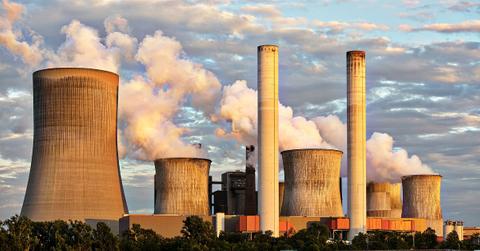What Is A Carbon Tax?
There's a carbon tax bill in the U.S. House of Representatives. But what does it do?
Updated May 31 2019, 3:06 p.m. ET
Lately, everyone’s talking about carbon taxes. On July 23, Representative Carlos Curbelo introduced a bill that would levy a tax of $24 per metric ton of carbon dioxide equivalent emissions in 2020, with the rate scaling up each year after that. It arrived right as a carbon tax proposal from the Climate Leadership Council was recirculating with new PAC support. While neither has passed or been adopted yet, these measures indicate bipartisan support for a carbon tax, since both Democrats and Republicans sit on the Climate Leadership Council. (Curbelo is a Republican.)
The chatter isn’t confined to America, either. Canada is currently finalizing numbers on the carbon tax plan for its 10 provinces, while nations ranging from The UK to Chile already collect fees on carbon emissions.
Carbon taxes are increasingly becoming international policy, but how exactly do they function in practice? Let’s break down the basics.
A carbon tax is a fixed fee on carbon emissions. It’s usually charged per ton, and it targets fossil fuels that release carbon dioxide when they burn — primarily, coal, oil, and natural gas. The government collects the money, just like any other tax, but the money comes from a variety of sources.
Carbon taxes are designed to decrease reliance on dirty power, so they hit fossil fuels directly at the source, levying wherever the carbon “enters the economy.” That means coal mines, oil and gas wells, or import terminals. Taxes in turn drive up the cost of these fuels, meaning individuals and businesses would have to pay more at the gas station or in their monthly utilities bills with a carbon tax in place. This would make renewable energy alternatives more cost-competitive.
It would also slash carbon emissions. The Brookings Institution says that a modest carbon tax can reduce emissions by 12 percent within 20 years. The Curbelo bill is aiming for a 27-32 percent drop from 2005 levels by 2025, and a 30-40 percent reduction by 2030.
Where the tax revenue goes depends on the policy. Many proposals favor using the money to cut payroll taxes, essentially giving taxpayers a rebate. Others call for actual rebates, like the Climate Leadership Council plan, which would distribute monthly sums to citizens via direct deposit, IRA contribution, or check. Curbelo’s bill includes detailed plans to invest the money in infrastructure, repairing roads and rebuilding coastal communities devastated by frequent flooding.
The revenue piece of the puzzle is crucial, since there’s rightful concern that a carbon tax would hit low- and middle-income households the hardest. Some critics also counter that carbon taxes are too conservative, making comparatively small dents in overall emissions.
So would a carbon tax have enough support to pass in the U.S.? Right now, it’s hard to tell. The current proposals seem unlikely to gain traction — particularly since the House of Representatives passed a resolution “expressing the sense of Congress that a carbon tax would be detrimental to the United States economy” before Curbelo’s bill even hit the floor.
As for the American public, opinion appears to be slightly in favor of carbon pricing. A March 2018 Gallup poll found that 53 percent of respondents favored a carbon tax, while 45 percent opposed it. (The remaining 2 percent had no opinion.)
The future of carbon taxes may be a bit murky, but with proposals on the table in the U.S., Canada, and other countries, it's a conversation that shows no sign of slowing as we continue to debate the best ways to fight climate change.
